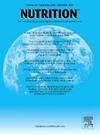一项随机对照试验:采用SSRD和低FODMAP的饮食干预后,IBS患者的血脂、血糖和维生素D水平得到改善
IF 3
3区 医学
Q2 NUTRITION & DIETETICS
引用次数: 0
摘要
背景肠易激综合征(IBS)是肠脑相互作用最常见的疾病,与超重有关。低含量的可发酵寡糖、二糖和单糖和多元醇(FODMAP)以及淀粉和蔗糖还原饮食(SSRD)可缓解肠易激综合征症状,但限制性饮食可能导致营养不良。本临床试验的目的是将IBS患者随机分配到SSRD组或低FODMAP组,并比较一段时间内循环代谢和营养状况。方法155例患者中,77例接受SSRD治疗,78例接受低FODMAP治疗,随访4周,随访6个月。完成了研究和Rome IV问卷调查、食物日记、IBS严重程度评分系统和IBS视觉模拟量表,并进行了血液采样和人体测量。分析血浆/血清白蛋白、c反应肽、糖化血红蛋白(HbA1c) (mmol/mol)、血脂(mmol/L)和微量营养素。结果两种饮食均可改善胃肠道和肠外症状。体重减轻在SSRD组最为明显(- 1.6(- 2.4至[- 0.4]kg vs. - 0.8(- 1.6至[- 0.1]kg; P = 0.006)。胆固醇(- 0.1(- 0.5 ~ 0.1),P = 0.007;- 0.2(- 0.4 ~ 0.1), P = 0.009),低密度脂蛋白(LDL) (- 0.2(- 0.4 ~ 0.1), P = 0.004;- 0.1(- 0.4 ~ 0.1), P = 0.017),非高密度脂蛋白(non-HDL) (- 0.1(- 0.4 ~ 0.1), P = 0.015;- 0.1(- 0.4至0.1),P = 0.008)在SSRD组第4周和第6个月下降,但在低FODMAP组仅在4周后下降(- 0.2(- 0.5至0.2),P = 0.003;−0.1(−0.3 ~ 0.1),P = 0.036;- 0.2(- 0.4 ~ 0.1), P = 0.002)。在第4周,两组的HbA1c降低(0(- 1.0至0),P = 0.010和(0(- 1.0至0),P = 0.009),维生素D增加(6(- 3至16)nmol/L, P = 0.004和4(- 5至14)nmol/L, P = 0.017), SSRD后维生素D水平继续升高。SSRD组叶酸增加,铁减少。低FODMAP后发现钙和铁蛋白水平降低。6个月时,两组的钴胺素水平均较低。结论sssrd和低FODMAP可改善症状及血脂、血糖和维生素D谱。SSRD组的脂质和维生素D谱在随访中仍有改善。本文章由计算机程序翻译,如有差异,请以英文原文为准。
Improved lipid and glycemic profile and vitamin D levels after a dietary intervention with SSRD and low FODMAP in IBS patients: A randomized controlled trial
Background
Irritable bowel syndrome (IBS) is the most common disorder of gut-brain interaction and associated with overweight. Low content of fermentable oligo-, di-, and monosaccharides and polyols (FODMAP) and a starch- and sucrose-reduced diet (SSRD) alleviate IBS symptoms, but restrictive diets may lead to malnutrition. The aim of the present clinical trial was to randomize IBS patients to either SSRD or low FODMAP and compare circulating metabolic and nutritional status over time.
Methods
Of 155 included patients, 77 received SSRD and 78 low FODMAP for 4 weeks, with a follow-up at 6 months. Study and Rome IV questionnaires, food diary, IBS-severity scoring system, and visual analog scale for IBS were completed, along with blood sampling and anthropometric measurements. Albumin, C-reactive peptide, glycosylated hemoglobin A1c (HbA1c) (mmol/mol), lipid profile (mmol/L), and micronutrients were analyzed in plasma/serum.
Results
Both diets improved gastrointestinal and extraintestinal symptoms. The weight reduction was most pronounced in SSRD (−1.6(−2.4 to [−0.4] kg vs. −0.8(−1.6 to [−0.1] kg; P = 0.006). Cholesterol (−0.1(−0.5 to 0.1), P = 0.007; −0.2(−0.4 to 0.1), P = 0.009), low-density lipoprotein (LDL) (−0.2(−0.4 to 0.1), P = 0.004; −0.1(−0.4 to 0.1), P = 0.017), and non-high-density lipoprotein (non-HDL) (−0.1(−0.4 to 0.1), P = 0.015; −0.1(−0.4 to 0.1), P = 0.008) decreased at week 4 and month 6 in the SSRD group, but only after 4 weeks in the low FODMAP group (−0.2(−0.5 to 0.2), P = 0.003; −0.1(−0.3 to 0.1), P = 0.036; and −0.2(−0.4 to 0.1), P = 0.002, respectively). At week 4, HbA1c decreased (0(−1.0 to 0), P = 0.010 and (0(−1.0 to 0), P = 0.009) and vitamin D increased (6(−3 to 16) nmol/L, P = 0.004 and 4(−5 to 14) nmol/L, P = 0.017) in both groups, with continued elevated vitamin D levels after SSRD. Folate increased and iron decreased in the SSRD group. Lower calcium and ferritin levels were found after low FODMAP. At 6 months, cobalamin was lower in both groups.
Conclusions
SSRD and low FODMAP improve symptoms and the lipid, glycemic, and vitamin D profiles. The improved lipid and vitamin D profiles remained at follow-up in the SSRD group.
求助全文
通过发布文献求助,成功后即可免费获取论文全文。
去求助
来源期刊

Nutrition
医学-营养学
CiteScore
7.80
自引率
2.30%
发文量
300
审稿时长
60 days
期刊介绍:
Nutrition has an open access mirror journal Nutrition: X, sharing the same aims and scope, editorial team, submission system and rigorous peer review.
Founded by Michael M. Meguid in the early 1980''s, Nutrition presents advances in nutrition research and science, informs its readers on new and advancing technologies and data in clinical nutrition practice, encourages the application of outcomes research and meta-analyses to problems in patient-related nutrition; and seeks to help clarify and set the research, policy and practice agenda for nutrition science to enhance human well-being in the years ahead.
 求助内容:
求助内容: 应助结果提醒方式:
应助结果提醒方式:


